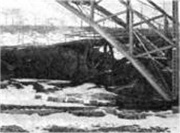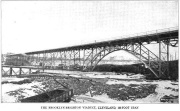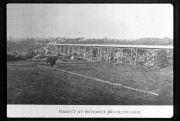|
| |||||
Brooklyn-Brighton Bridge
From Brooklyn Centre Wiki
| Line 2: | Line 2: | ||
[[Image:Brooklyn-Brighton_Bridge_(steel).jpg|thumb|Brooklyn-Brighton Bridge<br>''steel version''<br>Note that the original bridge can be seen just under the right part of the arch.]] | [[Image:Brooklyn-Brighton_Bridge_(steel).jpg|thumb|Brooklyn-Brighton Bridge<br>''steel version''<br>Note that the original bridge can be seen just under the right part of the arch.]] | ||
[[Image:Slide_Brooklyn_Brighton_bridge_-looking_south_%28pre-1915%29.jpg|thumb|Farmland below the bridge]] | [[Image:Slide_Brooklyn_Brighton_bridge_-looking_south_%28pre-1915%29.jpg|thumb|Farmland below the bridge]] | ||
| - | The Brooklyn-Brighton Bridge is located just south of [[Newburgh St.|Denison Ave.]] and is an extension of [[Pearl St.|West 25th Street]] where it spans [[Big Creek]]. More commonly known today as the Brooklyn Bridge. | + | The Brooklyn-Brighton Bridge is located just south of [[Newburgh St.|Denison Ave.]] and is an extension of [[Pearl St.|West 25th Street]] where it spans [[Big Creek]] near the [[Cleveland Zoological Park]]. More commonly known today as the Brooklyn Bridge. |
==HISTORY== | ==HISTORY== | ||
Revision as of 20:06, 4 September 2010
The Brooklyn-Brighton Bridge is located just south of Denison Ave. and is an extension of West 25th Street where it spans Big Creek near the Cleveland Zoological Park. More commonly known today as the Brooklyn Bridge.
Contents |
HISTORY
The Brooklyn-Brighton Bridge provided a link between Brooklyn Centre on the north and Brighton Village (later known simply as Brooklyn or Old Brooklyn) on the south. The valley below had been difficult to travel by early settlers wanting to bring their goods to market in Cleveland. Driving oxen pulling a wagon laden with farm products would have been a challenge. The hills at either end of the valley were steep and hard enough for a human to walk up, much less for an animal with the burdens they were expected to pull.
It's hard to imagine it now, but the valley below the bridge was at one time farm land and a pasture for the livestock of Moses Fish and his brother, Ebenezer Fish. It's very likely that their cousin, James Fish, who lived just a short distance north of Ebenezer, also had his livestock graze down there. Decades later, the valley became more and more industrialized and the farm land was gone.
BRIDGE VERSIONS
Over the last two centuries, several bridges have been constructed in this same general location.
It is interesting to note that the concrete bridge built in 1916 is fully a thousand feet longer than the previous bridge. It is difficult now to imagine exactly where this earlier bridge's terminuses were that would account for that difference in length.
pre-1887
- Small bridge spanning Big Creek
- An article in the Cleveland Plain Dealer mentioned the width of the bridge was 16'4" and in dilapidated condition in 1852.[1]
1887 to 1897
- Iron bridge 1,140' long, 53' high.
- The plan of Walter Rice was adopted by the county commisioners in June of 1886 for an iron bridge with wooden approaches at both ends. The iron for the bridge was purchased and subsequently shipped from the Pittsburgh firms: Jones & Ogden and Oliver Brothers[2]
- Construction began in the winter of 1886 by the Buckeye Bridge and Boiler Works. They suffered a fatality of one of their crew when George Nichols fell from the bridge thirty feet to the ground below.[3]
- By July 1st, 1887 the bridge was nearly completed at a total cost of $40,000.[4]
- Dedication of the bridge was on July 4th, 1887 at 10:00 a.m.
1897 to 1915
- Steel bridge
- The span consisted of a bridge 1,540 in length with a 29-1/2' roadway + 7' sidewalks on either side.[5] The road surface was wooden planking. Total cost including land was $170,000. Later condemned as unsafe.[6]
1916
- Concrete bridge
- The span consisted of a bridge 2,265' in length with a 76' wide roadway. Two streetcar tracks run along the center. Overall cost was a bit over half a million dollars.[7] Paved with Balfour Granite, commercial name "Durax Paving" of the Harris Granite Quarries Company of Salisbury, N.C.
- During the construction of the bridge in April of 1915, a severe gale dislodged one of the concrete forms which plunged to the valley below taking with it four workmen. The men were trapped beneath the heavy timbers that made up the form and needed to be rescued.[8]
Denison Square Jubilee Week
The Brooklyn-Centre community celebrated the bridge opening by having a large week long festival. The following article appeared in The Cleveland Enterprise, September 1, 1915:
---
Crowd Midway and Enjoy Band Concerts as Cool Autumn Weather Adds Zest to Festivities
---
CONTESTS ARE HOTLY WAGED
---
Lights and Flags Make West 25th St. Resplendent -- Big Searchlight Illumines Scene -- Special Features Each Evening
---
"Why," he continued, "ever since I can recollect we have fought each other like cats and dogs. And jealous! Gosh, but how jealous we've all been, and scarcely a one of us big enough or important enough to afford being jealous.
"The idea of our ever doing anything together was always thought ridiculous. We never advertised before -- it cost too much, we not realizing that advertising pays for itself many times over. But now just see what we've done!" and his arm swept back and forth as he pointed up and down W.25th street.
W. 25th street from the Brooklyn bridge to Mapledale avenue is ablaze with lights, streamers and bunting. The midway stretches along the north side of Willowdale avenue and on W. 25th street opposite Selzer avenue. On W. 25th street in front of the old Brooklyn M.E. church is the band stand.
The carnival officially opened Monday.
Tight-rope walker, "Prince Nelson" [text missing] wire, stretched from the fourth story of the Rosesheer block across W.25th street.
Tuesday night a band concert was the attraction. Thursday night is fraternity order night. Friday night a confetti carnival is scheduled. Saturday night the various contest winners will be announced and the most popular lady crowned queen of the jubilee.
The contests are as follows: Popular woman, homely man, prettiest child, popular schoolgirl.
In the popular woman contest Miss Ruby Smith, Miss Edna Zepp, Miss Katherine Bower and Miss Helen Moell are having a close race.
Charles Lechner, fireman, leads as homeliest man. Baby Gunderman as the prettiest baby and Malvina Fisher as the most popular schoolgirl.
Votes in all contests are a penny.
Great crowds have attended the carnival both nights. The fall weather has been ideal for carnival purposes, and the vendors of hot dogs and coffee have been kept busy.
The carnival is given under the auspices of the Denison Square Improvement association, of which Geo. Weckerling of the Brooklyn Savings & Loan Co. is President. The celebration is in charge of a committee of which J. C. Cowgill is chairman, Others on the committee are H.C. Brock, W.R. Reeves, W.E. Janoes, J.L. Glock, P.M. Farnsworth, Mr. Weckerling, William Shaffer and Benjamin Luse.
Open-air free vaudevuille and midway attractions are operated both afternoon and evening.
--The Cleveland Enterprise, September 1, 1915
REFERENCES
- ↑ Cleveland Plain Dealer, September 14, 1852 issue, page 1
- ↑ Cleveland Plain Dealer, November 30, 1886 issue, page 8
- ↑ Cleveland Plain Dealer, January 25, 1887 issue, page 8
- ↑ Cleveland Plain Dealer", July 1, 1887 issue, page 6
- ↑ Types and Details of Bridge Construction, By Frank Woodward Skinner, 1904, page 118
- ↑ The Bridgemen's magazine, By International Association of Bridge and Structural Iron Workers, Indianapolis, Vol. XIII No.1, January 1913, pages 50 and 815
- ↑ Bridges of Cleveland and Cuyahoga County, 1918
- ↑ Cleveland Plain Dealer", April 12, 1915 issue, pg.1
Help support this website by visiting some of the Ads provided by Google.







